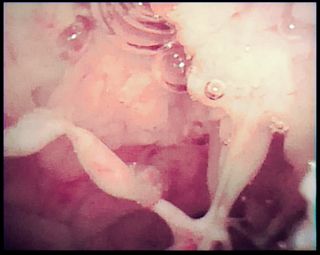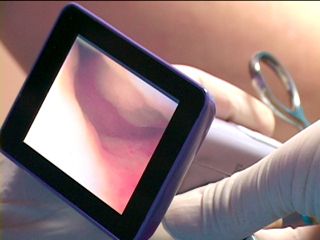Comparing Conventional Hysteroscopes to the Investigational Office Hysteroscope
Dr. Indman compares the conventional hysteroscope with the new office based system.

Hope Waltman: Last week we discussed the new self-contained office hysteroscope you are developing. Have you been able to use that in patients yet?
Dr. Indman: Although our hysteroscope has not yet been cleared by the FDA for commercial use it has been approved for evaluation in a clinical trial. In this trial we have been able to perform hysteroscopy on a number of women.
Hope Waltman: How is using this hysteroscope different than using a conventional hysteroscope?
Dr. Indman: There are a number of hysteroscopes available. Conventional hysteroscopes require an external light source. You can look directly through the eyepiece, but most gynecologists attach an external camera and view the picture on a video monitor. Some newer hysteroscopes have a built in camera but still require external electronics as well as a light source. All currently available hysteroscopes have to go through a sterilization process before use. In this hysteroscope the portion that goes into the uterus comes in a sterile package, and the video screen, with all the electronics, is contained in a small reusable handle.
Hope Waltman: Do you have any pictures taken with this?
Dr. Indman: Here is a picture showing a number of polypoid growths in the endometrial cavity. Endometrial biopsy confirmed the diagnosis of endometrial polyps.

Image: Endometrial Polyps
Here is a short video showing the use of the hysteroscope in a woman with postmenopausal bleeding. As the hysteroscope enters the uterus a submucous myoma is seen at 7 o’clock in the just beyond the cervix. What appears to be a small polyp at 12 o’clock is seen as the hysteroscope is withdrawn. Endometrial sampling is done to confirm the diagnosis

Video:Investigational Office Hysteroscope Allows More In-Office Evaluation of Endometrial Cavity Hope Waltman: What do you see as the future of office hysteroscopy?
Dr. Indman: Hysteroscopy should be done before scheduling an endometrial ablation to rule out submucous myomas and other pathology that could interfere. Sterilization with the Essure or Adiana devices is becoming more in demand. There are a number of advantages to doing this in an office setting, but hysteroscopy equipment is required.
Having started office hysteroscopy thirty years ago, I quickly realized that the ability to see inside the uterus is as valuable to me as it is for an ENT doctor to look in an ear. My dream has long been to bring hysteroscopy into every gynecologist’s office. The high cost of equipment and large amounts of staff and physician time required for the use of conventional hysteroscopes, are barriers that keep most gynecologists from doing this essential office procedure. I’m hoping that the availability of a cost-effective simple office hysteroscope system will bring hysteroscopy into the office of every gynecologist.
Part I of the Interview - New Device Makes Office-Based Hysteroscopy Possible
Mindfulness in the operating room
December 4th 2022During a poster presentation at AAGL’s 51st Global Congress on MIGS, Elizabeth Miasma, MD, LLM, University of Toronto, St. Michael’s Hospital, discussed her research on mindfulness practices to optimize resident surgical performance.
Read More
Do box trainers and surgical simulators make a difference?
December 3rd 2022In a session on Saturday during AAGL’s 51st Global Congress on MIGS in Aurora, Colorado, Angie Tsuei of Western Michigan University discussed the results of an investigation into the impact of homemade laparoscopic box trainers on medical students’ surgical skills.
Read More
Are ob-gyns comfortable discussing sexual trauma with patients?
December 3rd 2022Hannah C. Karpel, MS, New York University Grossman School of Medicine, discussed the findings from an investigation into ob-gyn clinician comforts and barriers associated with addressing sexual trauma in a poster presentation at AAGL’s 51st Global Congress on MIGS in Aurora, Colorado.
Read More
Patient experiences with a multidisciplinary fibroid program
December 3rd 2022During a poster presentation at AAGL’s 51st Global Congress on MIGS, Kelsey Musselman, MD, discussed her research regarding patient experiences with fibroid management before and after consultation at a multidisciplinary fibroid center.
Read More
